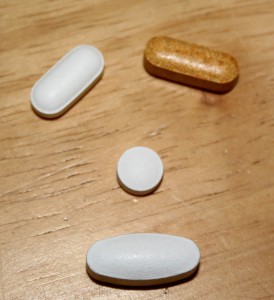
In an recent review in World Psychiatry, Khan and Brown (2015) look at antidepressants for depression and trace a few of the possible causes responsible for the apparent narrowing of the drug-placebo gap.
The authors start by observing that over the last two decades the widely held notion that antidepressants worked for 70% of depressed patients and placebos for 30% has largely been superseded. The origin of this statistic lies within the first studies on imipramine and early clinical trials with tricyclic antidepressants, which included severely depressed patients, such as hospitalised depressed patients with a melancholic pattern of symptoms.
DSM-III: a broad diagnostic category for major depressive disorder
Khan and Brown (2015) pinpoint to the introduction of the Diagnostic and Statistical Manual of Mental Disorders (DSM)-III as a turning point in reducing the distance between antidepressants and placebos. As an atheoretical system, which minimised the differences between various depression subtypes (which had been the focus of research so far) and over-imposed a broad diagnostic category called major depressive disorder, the DSM-III made it possible that a significantly larger number of individuals could now be categorised as depressed. Since literally millions of individuals had now “become” depressed (and not just the very severe cases from the first trials), depression was now a fertile ground for pharmaceutical companies to start exploiting. As Khan and Brown (2015) put it
the American Psychiatric Association, sponsor of the DSM-III, unintentionally expanded the market for antidepressants.
(I retain my doubts about the unintentional part).

The diagnostic category of major depressive disorder introduced in DSM-III significantly increased the number of depressed people who could be prescribed antidepressants worldwide.
Development of SSRIs and SNRIs
There then followed an explosion of drug development research that saw the rise of new categories of drugs (selective serotonin reuptake inhibitors (SSRIs) and serotonin and norepinephrine reuptake inhibitors (SNRIs)). New analysis of the public domain data of the US Food and Drug Administration (FDA) found that 40% was a more accurate estimation for the magnitude of symptom reduction with antidepressants, as compared to 30% achieved with placebo (Khan et al., 2000).
On the other hand, another analysis (Walsh et al., 2002) of published clinical reports of antidepressants showed that the degree of treatment response with placebo had been increasing over the last thirty years.
Expectation bias
Another factor identified by Khan and Brown (2015) refers to the impact of the expectation bias. In a recent analysis (Khan et al., 2012) they compared antidepressant trial data from non-pharmaceutical industry sources to industry data (obtained from the FDA Freedom of Information Act) and evaluated the magnitude of symptom reduction with all treatments, as well as their active and passive controls, such as placebo. Two interesting sets of results emerged:
- First, the size of symptom reduction for the placebo pill was higher in the trials not sponsored by the pharmaceutical industry.
- Second, in trials where investigators, staff and patients were blinded to the trial design and execution, symptom reduction was smaller for all treatments and control conditions considered, and differences between treatments and controls were also reduced. In fact, patients assigned to all of the treatments, whether considered active or designed as control conditions, showed symptom reduction that was strikingly similar to that observed with placebo. In other words, blinding of investigators and patients effectively wiped out differences between treatments, control and placebo. Interestingly, for the treatment and control conditions where blinding was impossible (combined pharmacotherapy and psychotherapy, and respectively waiting list), the degree of symptom reduction compared to placebo was higher. Compared to placebo, combined treatment showed a superior response and waiting list an inferior one, as if, the authors noted:
clinicians and depressed patients continued to fulfil expectations of each treatment based on prior assumptions.
Another study (Sinyor et al., 2010) indicated that the number of drug and placebo arms in a trial influenced the apparent therapeutic effects of the drugs, when this number was known to clinicians and patients. If the probability to be exposed to placebo was reduced, the therapeutic effects were higher for both the antidepressant and placebo.

Blinding of investigators and patients in depression studies effectively wiped out differences between treatments.
Understanding and supporting natural recovery
Citing experimental data supporting the almost ubiquitous nature of placebo effects across chronic conditions with a fluctuating course, and noting that while differences between existing treatments for depression are small, rates of spontaneous remission are comparably high. We wondered in a recent commentary (Cuijpers and Cristea, 2015) whether a placebo effect might in fact explain most, if not all, the variability among treatments for depression. As a consequence, we suggested research might veer away from trying to discover new, specific treatments for depression and instead focus on trying to understand and support natural recovery.
Penalising well designed trials
Finally, Khan and Brown (2015) identify regulatory decisions by bodies such as the FDA and the European Medicines Agency (EMA) as another relevant, yet largely under-appreciated factor. They detail how given their main focus is avoiding possible false positives, these regulating bodies set up requirements and favour trials that may not have the best design and development, in terms of outcome measures, data analysis methods, or number of treatment arms. This further exacerbates difficulties and confusion in interpreting data from these trials.
Conclusion
The authors conclude their review with a bleak but honest estimation regarding the effect sizes of current antidepressant trials:
The effect size of current antidepressant trials that include patients with major depressive episode is approximately 0.30 (modest), and this fact needs to be heeded for future antidepressant trials.

Recent research finds no difference between antidepressants and placebo in terms of depression symptom reduction.
Links
Primary paper
Khan A, Brown WA. (2015) Antidepressants versus placebo in major depression: an overview. World Psychiatry Off. J. World Psychiatr. Assoc. WPA.
Other references
Cuijpers, P., Cristea, I.A., 2015. What if a placebo effect explained all the activity of depression treatments? World Psychiatry Off. J. World Psychiatr. Assoc. WPA 14, 310–311. doi:10.1002/wps.20249
Khan, A., Faucett, J., Lichtenberg, P., Kirsch, I., Brown, W.A., 2012. A systematic review of comparative efficacy of treatments and controls for depression. PloS One 7, e41778. doi:10.1371/journal.pone.0041778
Khan, A., Warner, H.A., Brown, W.A., 2000. Symptom reduction and suicide risk in patients treated with placebo in antidepressant clinical trials: an analysis of the Food and Drug Administration database. Arch. Gen. Psychiatry 57, 311–317. [PubMed abstract]
Sinyor, M., Levitt, A.J., Cheung, A.H., Schaffer, A., Kiss, A., Dowlati, Y., Lanctôt, K.L., 2010. Does inclusion of a placebo arm influence response to active antidepressant treatment in randomized controlled trials? Results from pooled and meta-analyses. J. Clin. Psychiatry 71, 270–279. doi:10.4088/JCP.08r04516blu [PubMed abstract]
Walsh, B.T., Seidman, S.N., Sysko, R., Gould, M., 2002. Placebo response in studies of major depression: variable, substantial, and growing (PDF). JAMA 287, 1840–1847.
Photo credits


Antidepressants vs placebo for depression: forget the gap https://t.co/7m3sDjCFep #MentalHealth https://t.co/RElwj1H4B8
RT iVivekMisra Antidepressants vs placebo for depression: forget the gap https://t.co/QGvNKiIadm #MentalHealth https://t.co/JwcmUaqO4f
Antidepressants vs placebo for depression: forget the gap https://t.co/TBzB5YBQq1 via @sharethis
RT mark_bolstridge: Antidepressants vs placebo for depression: forget the gap https://t.co/57dLPuqjbh via sharethis
So if the drugs don’t work, can they make you worse?
So which is it? Patient selection or placebo effect? If the former, then we all simply need to turn back the diagnostic clock to pre-DSM-III. If the latter, then as you say, we must redeploy resources away from drugs. I can see many patients being unhappy with the idea that there is no pill for their ill, however.
My new @Mental_Elf post Antidepressants vs place 4 depression: forget the gap https://t.co/7jHPDGHmNC
Antidepressants vs placebo for depression: forget the gap https://t.co/sAcTYMQnhK
Antidepressants vs placebo for depression: forget the gap https://t.co/vkcSef8Zf7 via @theoldreader
RT @Mental_Elf: Today @Zia_Julia on why there’s no diff btwn antidepressants & placebo in terms of depression symptom reduction https://t.c…
RT @Mental_Elf: How much can expectation bias skew the results of antidepressant trials? https://t.co/FfboLksllv
“The effect size of current antidepressant trials that include pts w major depressive episode is approximately 0.30” https://t.co/FfboLkJWK5
@Mental_Elf if that
#Antidepressants vs placebo for #depression: forget the gap https://t.co/dfs4loB3tx via @sharethis
Una revisión concluye que NO hay diferencias entre antidepresivos y placebo en reducción de síntomas en la depresión https://t.co/Ufxv7JVUB5
RT @Mental_Elf: Should we stop looking for new depression treatments & instead focus on understanding & supporting natural recovery? https:…
RT @Mental_Elf: Blinding of investigators & patients in depression studies effectively wiped out differences between treatments https://t.c…
Don’t miss: Antidepressants vs placebo for depression: forget the gap https://t.co/FfboLkJWK5 #EBP
Antidepressants vs placebo for depression: forget the gap https://t.co/ZTVZSOb8yv vía @sharethis
Antidepressants vs placebo for depression: forget the gap https://t.co/h61009YGaO via sharethis Interesting article!
@dxrevisionwatch @UoHHealthSocSci Which commentary? Do you mean @Zia_Julia’s blog from yesterday? https://t.co/FfboLkJWK5
@Mental_Elf This report https://t.co/AU7korweiN which @UoHHealthSocSci T’d
@Mental_Elf @UoHHealthSocSci “The main therapy offered for mental health service users is psychotropic medication, that can…”
@Mental_Elf @UoHHealthSocSci “increase the likelihood of a meaningful recovery…” Curious to know what is understood by term.
Antidepressants vs placebo for depression: forget the gap. https://t.co/alqjNs2Sun by @Mental_Elf #TopShared24hrs #2
Antidepressants vs placebo for depression: forget the gap https://t.co/edgjA2H0kl via @sharethis
Antidepressants vs placebo for depression: forget the gap https://t.co/Lfnr6xVYqX via @sharethis
Why the apparent decline in anitdepressant-placebo gap? Estimates of depression reduction effects fall frm 70 to 30% https://t.co/pSqZH8g9l1
Antidepressants vs placebo for depression: forget the gap https://t.co/fOYWidCCKZ
[…] http://www.nationalelfservice.net/mental-health/depression/antidepressants-vs-placebo-for-depression… […]